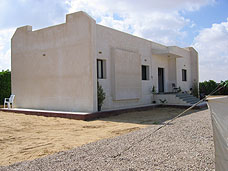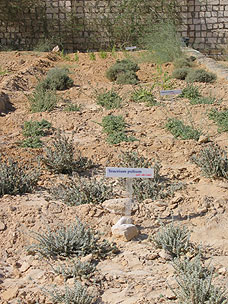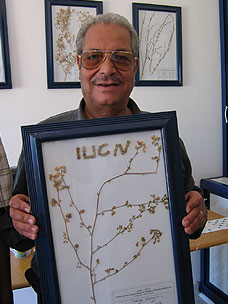The Centre and Garden for the Conservation of Endangered Plants were created, thanks to the effort of Prof Kamal Batanouny, Egypt’s National Coordinator, to serve as an education and awareness centre for the entire region, as well as conserve threatened medicinal plants in North Africa.
The Centre and Garden are located on a rocky ridge at El-Hammam, 65 km west of Alexandria, in Egypt. The land, covering 5400 square meters, was donated by the Governor of El-Hammam and comprises of a visiting centre, a gardener's room and a garden.

The objective of the Centre is to:
- Conserve the threatened and rare economic plant species, especially those of medicinal value.
- Raise awareness among the stakeholders and users about the value of conservation.
- Document the traditional knowledge about the use of plants to help conservation of Intellectual Property Rights (IPR).
- Support education in the field of biodiversity conservation.
- Provide researchers with facilities to undertake experiments on cultivation, propagation, harvest and phytochemical investigation of the plants.
The Centre focuses on local plant species, but has also gathered and cultivated endangered plant specimens from the wider North Africa region.
Almost half of the area is devoted to the garden, being divided into 5 sectors. The other half is left natural to follow and monitor changes resulting from protection and to perform experiments on the effect of rainfall and other factors on the habitat and vegetation. The Centre includes a meeting hall, an office, an entrance and facilities. 
The following activities have taken place:
- Cultivation of endangered and rare medicinal and aromatic plants and other economic plants. This was achieved through various activities, including the collection of propagules (seeds, corms, bulbs, cuttings, rhizomes, etc.) and trials to cultivate the plants under different conditions.
- Plant propagation. Transplants and propagules were exchanged with the nurseries of the Bedouin communities, so that they could propagate the plants. Trials to propagate the plants were made in the experimental part of the garden by researchers.
- Public Awareness. The Centre was visited by university and school students, biology teachers, young researchers, tourists and youth from the summer resort villages. Awareness was raised through the organization of workshops, seminars and lectures, the distribution of educational material and the display of video films and other materials.

- Documentation of Traditional Knowledge. Bedouin communities, herbalists and healers were interviewed to gather information about their traditional knowledge. A compendium was prepared with the collected data and other activities towards the conservation of intellectual property rights (IPR) were supported.
- Training. Training was given to science teachers, local communities, technicians, students, young researchers and herbalists on conservation of biodiversity, medicinal plants and folk medicine, cultivation and propagation of wild medicinal plants, as well as participatory approach methods.
|


